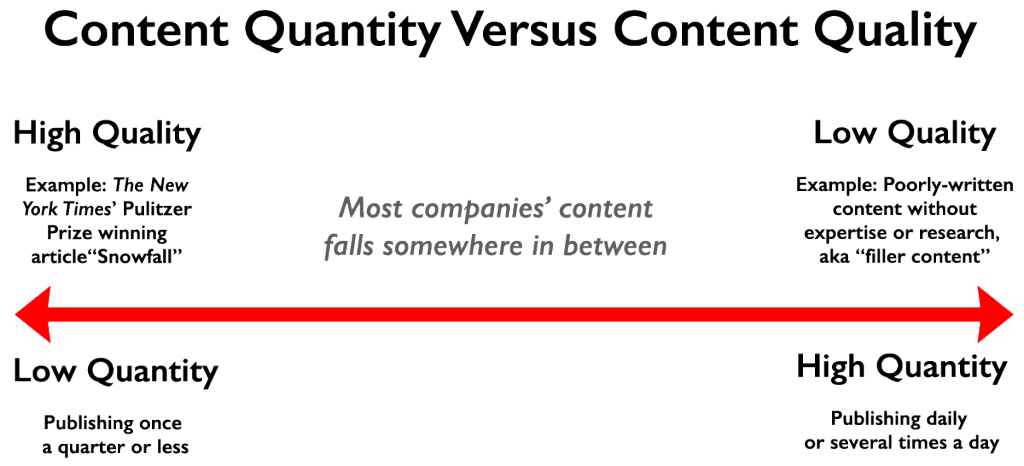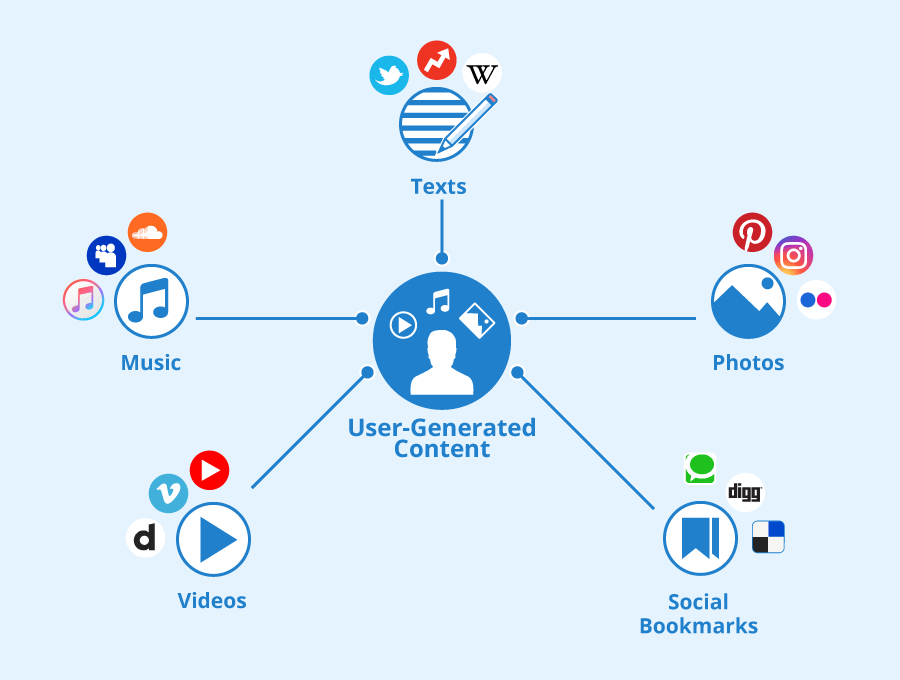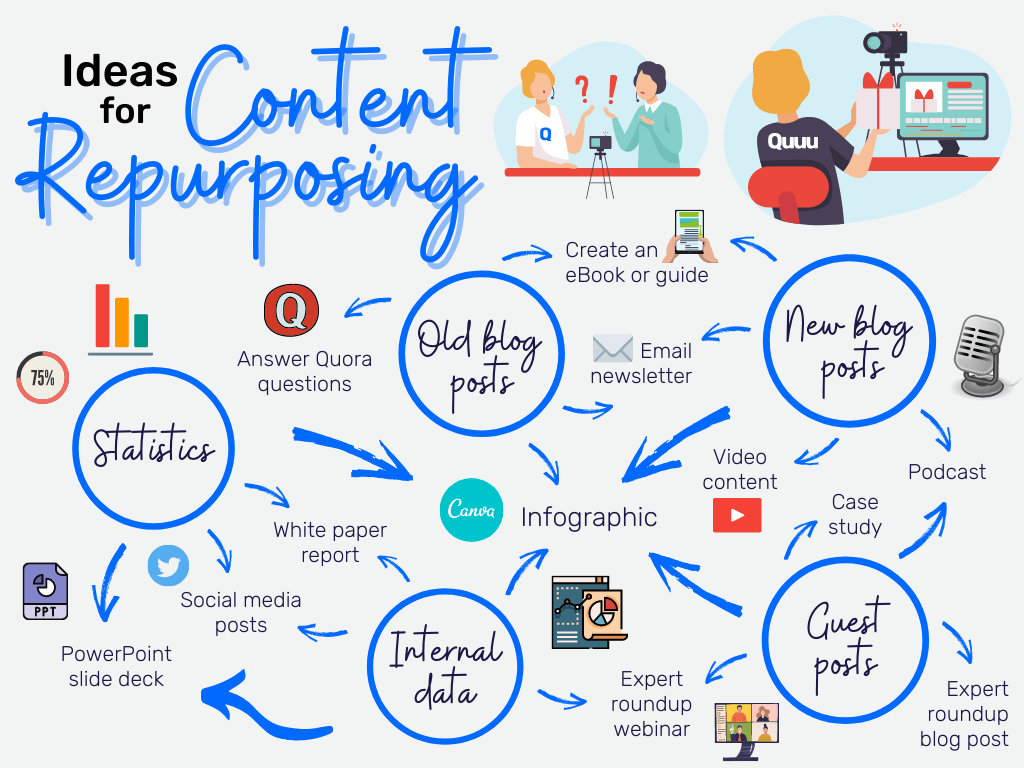
Creating content for a B2B audience is becoming increasingly complex in an ever-changing digital marketing landscape. Technology is rapidly evolving, and it’s become increasingly crucial for B2B companies to stay ahead of the curve. Therefore, it’s vital to have a strategy that accelerates your content creation process in 2023.
When done correctly, B2B content creation boosts brand visibility by providing valuable information on topics relevant to your target audience. It allows companies to establish authority as thought leaders while gaining an edge over the competition.
Content also builds relationships with prospects and existing customers, leading to trust and brand loyalty. A great content strategy has many steps and moving pieces.
To keep things interesting and your target audience engaged, your team must consistently develop new content and update existing content.
When writing B2B-focused material, it’s essential to have a solid SEO strategy. Include relevant keywords throughout each post to ensure search engines rank your site in relevant searches. Additionally, social media platforms can give your content additional exposure.
This guide will discuss 13 strategies to accelerate your B2B content creation process while maintaining quality standards.
Effortlessly export your Google Docs to WordPress with just 1-click.
Get Started Today
Having a well-thought-out plan before beginning work helps keep everyone aligned throughout the creation process resulting in greater efficiency. 62% of the most successful B2B organizations have a documented content strategy, including an editorial calendar.
An editorial calendar allows organizations to track progress against deliverables and ensures everything follows the original timeline. Having an editorial calendar can also help you plan with more accuracy.
The best way to get started is by creating a standardized process. This process outlines the critical stages of content creation, from idea generation and research to editing and publishing.
That said, having clear expectations at every step benefits everyone involved. That way, you’re aware of every deadline, and so is your team. No surprises.

Always choose quality B2B pieces with visuals, stories, and insights that grab attention over lower-quality articles, posts, or videos.
Quality over quantity is the key to successful B2B content marketing. Businesses must focus on producing high-quality, relevant content that solves customers’ problems and helps them make better decisions.
Content should be engaging and informative, providing readers with valuable information in an easy-to-understand format. The way to develop such content is for businesses to conduct market research before production. Such research will allow them to create targeted messaging that speaks directly to potential buyers’ needs.
If they do that, they can expect high-quality content that’ll be valuable to customers and drive results for the business.

An email finder software enables marketers to access contact information associated with various prospects. These tools allow teams to target specific individuals rather than broad groups. This strategy increases response rates significantly.
Businesses should use tools like these when sourcing leads for important campaigns or trying to establish meaningful connections during outreach initiatives.
ContactOut is one of the most popular email finder software solutions. It offers a robust and reliable way to search for contact information, letting users access LinkedIn profiles quickly to get more details about specific leads.
FindThatLead is another excellent option when looking for email addresses in bulk. It lets you search for leads using keywords and website domains. The tool also includes advanced filtering options to narrow down the results according to various criteria such as company size and job title.
MailTester is yet another helpful solution when searching for emails across multiple sources. This service helps marketers verify certain accounts by testing them against real-time data from several providers, including Google, Yahoo!, and Microsoft Live. The test guarantees email delivery by ensuring you send that the email address is valid.
Hunter.io’s Email Finder is a valuable addition to the arsenal of email finder software options. This tool empowers marketers by providing access to contact information associated with a wide range of prospects. With Hunter.io, teams can precisely target specific individuals, increasing their response rates significantly. Like other top email finder solutions, Hunter.io streamlines the lead-sourcing process for important campaigns and outreach initiatives. It is an essential tool for businesses seeking to establish meaningful connections with their prospects.

Artificial intelligence (AI) algorithms like natural language processing (NLP) have become increasingly advanced. They now understand complex customer needs and generate ideas based on these insights. As a result, this technology can significantly reduce the time spent researching potential topics while guaranteeing relevance across multiple markets.
One way to use AI for content creation in B2B is through topic generation. It can involve using NLP algorithms and machine learning (ML) models.
These models analyze customer conversations, previous articles or case studies, and industry news sources. As a result, they generate ideas tailored to the needs of a particular company or market segment.
You can also use sentiment analysis technology to find user feedback trends and create content around those topics. Analyzing customer reviews across multiple channels (forums, social media platforms) makes it possible to identify critical areas where customers have expressed crucial feedback. Understanding customer frustration with particular features or services helps businesses develop content to address these issues.
Finally, you can use AI-driven analytics tools to optimize existing content. For example, tracking how users interact with specific pages over time provides data to optimize your website. This data could be things like which titles or subheadings of web pages or blog posts attract the most attention.

Keep close tabs on emerging trends across niche segments. Look into markets specifically related to your company’s B2B needs. Identifying these trends allows you to remain up-to-date about potential shifts in buyer behavior patterns.
The following steps can help identify trends in niche segments:

Encourage customers to provide feedback on products or services through reviews or surveys. In this way, you gain a new understanding of what they’re looking for from your business, which should inform your future marketing efforts.
User-generated content can also inspire products and services. For example, listening to customer feedback allows you to gain insight into what product they’re looking for and can even create custom solutions based on their needs.
Implementing QR codes using a QR code creator in your marketing materials can enhance customer engagement by providing quick access to relevant information or exclusive offers.
Additionally, user-generated content offers an opportunity to generate more organic reach through social media platforms such as Twitter and Instagram. Encourage customers to share pictures of your products with branded hashtags to help other potential customers find them easily when searching online.
User-generated content is a great way to build relationships with existing customers while attracting new ones. Showing users that you value their opinion makes them feel appreciated and can earn you repeat business.
Live Q&A sessions with industry experts provide a unique opportunity for B2B marketers to create educational and entertaining content. It gives audience with detailed, informative answers from an expert in their field. At the same time, this provides companies with valuable data on user preferences and customer feedback.
You can use this content across various mediums, such as webinars, podcast interviews, or live-streaming events. Additionally, use platforms where users may ask questions directly via social media sites like Twitter and Facebook.
Companies can also use this data to improve their products, services, and future marketing campaigns based on customer input during these sessions.

Invest in quality content creation tools like a good CMS (Content Management System) or an AI-powered WYSIWYG (What You See Is What You Get) editor to efficiently create dynamic content.
In B2B content creation, a CMS is a high-value management tool. It can manage all your content and copy, including website pages, blogs, whitepapers, press releases, sales brochures, and case studies.
A CMS allows you to store and use assets across multiple platforms to produce output quickly and easily. So businesses save time while ensuring consistency in branding messages delivered by their marketing team.
Also, some CMS have analytics tools that let marketers track performance metrics like page views and conversions for each piece of material created.
The list in the graphic above is Forbes’ list of “The Best CMS of 2023.”
Reach out beyond local markets by launching multilingual campaigns targeting international audiences. Creating localized versions would ensure a better understanding of product offerings, thus gaining traction among potential customers who speak different languages.
Start by targeting the most popular languages in the areas you aim for. Then, appropriately translate your website, headers, content, and product descriptions.Ensure the accuracy of translations, as a mistake can result in customer dissatisfaction or even lost sales opportunities.
But make sure that your content still “sounds like you.” Work hard to get your brand voice “just right,” so don’t trust an automated translator tool to do it justice. Manual translation is best. Or you can try Smartling integration.
Add quizzes, polls, and surveys to blog posts/articles to improve the user experience. Doing this helps capture attention spans more effectively than text alone.
Employ multiple platforms to give the same experience no matter the user’s device, improving the UX.
When creating content for B2B, you need to focus on making sure the experience is seamless across all devices. For example, your website must work well (and look great) on mobile devices, tablets, and desktop computers. Developing apps for different operating systems or platforms, such as iOS or Android, is also best.

Make the most of existing pieces by repurposing them into formats like ebooks, webinars, or video tutorials to reach new audiences. For instance, create an ebook from existing blog posts, webinars from podcasts, and video tutorials out of infographics.
Ebooks: Take a series of related blog posts that you have already published to create an in-depth guide on the subject for your customers or prospects. Make sure to include plenty of visuals like screenshots or diagrams to break up text-heavy sections.
Webinars: Get creative with repurposing audio content into engaging, interactive webinars by adding slideshows and graphics during playback. Encourage audience participation through Q&A sessions at the end using conference call software like Zoom.
Video Tutorials: Create short step-by-step videos using visual elements that help explain complex concepts. Break down lengthy topics into bite-sized chunks applicable to social media platforms like YouTube, Instagram, and TikTok.

Incorporate visuals into your B2B storytelling approach by using videos or graphics. These visuals should represent what your brand stands for — its mission statement or core values — so they convey the right message effectively without the constant need for words.
Creating quality B2B content can be challenging, but with the right strategies, it doesn’t have to be. By following these 13 strategies, your business can speed up content creation and create engaging pieces that resonate with your target audience. Once you’ve done that, your company can’t help but succeed.